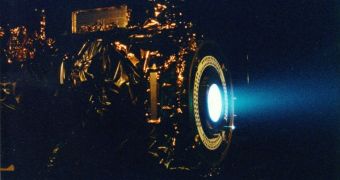Well, not exactly... I mean they will not reach superluminal speeds or something, not to talk about the high acceleration capabilities or thrust. Astrium, the contractor of the construction of the BepiColumbo spacecraft, which is scheduled to launch in 2013 in a mission to planet Mercury, stated that the probe will receive a set of brand new ion engines to power it. The reason for this? Considering that most of the spacecrafts sent to study the solar system had extended missions and the vast majority have been stopped due to fuel shortages, than the ion drive is probably the best solution for a fuel-economic vehicle.
BepiColumbo will make a six years long journey to planet Mercury when its engines will probably reach an efficiency of about 7.6 million kilometers per liter, making it ideal for long duration missions. The task for building the engines was given to British space engineers.
Ion engines, also known as ion thrusters, represent an electric propulsion system, primarily used by spacecrafts to create a thrust force by accelerating ion particles with the help of electrostatic or electromagnetic forces. They usually produce relatively low thrust forces and are only used for space propulsion because they are highly inefficient, requiring high power inputs.
The basic principle on how these engines work was first described by German physicist Hermann Oberth, pointing out the advantages of saving high quantities of heavy fuel through the use of electric engines. The first working device was constructed in 1959 by Harold R. Kaufman at NASA's Glen Facilities, tested between 1960 to 1964, and was using mercury as fuel.
Although several constructive designs exist, all ion engines work on the same principle. Electrically charged particles are used to create thrust in concordance with the third law of motion. The ratio between charge and mass enables the use of relatively small potentials, meaning that it can produce very high exhaust speeds, reducing the amount of reaction fuel and increasing the specific power. Although ion drives can produce high specific impulses, their low thrust represents a disadvantage.
It has been previously used with high success by both NASA and ESA in space mission such as Deep Space 1, Artemis or LISA Pathfinder.

 14 DAY TRIAL //
14 DAY TRIAL //